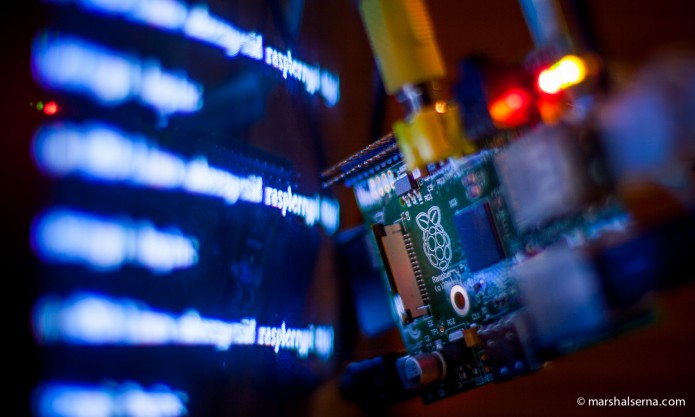
Reading Ebon Uptons’ forward to the Raspberry Pi User Guide I couldn’t help but feel we are entering a new, exciting time in the evolution of technology. This tiny computer brings affordable, easily programmable Physical Computing to the masses, changing the equation for anyone interested in learning about how computers work and how to make them do things in the real world. While the Raspberry Pi was intended to enable, inspire and educate young people, the maker community has gone crazy for the idea. From now on there will be small, affordable, capable computers that can easily sense and control things in the physical world. These computers will keep getting smaller, cheaper and faster. This is just beginning.
Thoughts and potential projects based on the Raspberry Pi…
I acquired my first Raspberry Pi, already at Revision 2, for Christmas 2012. I’m basically just getting started with it. There’s a lot for me to learn, and I have limited amounts of time to devote to the endeavor. To start, I don’t have much experience with Linux, or Python – I’m still wrapping my head around the C-like environment for Arduino. There are layers and layers of system administration to grasp before I start to do even the simplest physical computing projects with the Pi. Seemingly routine things like WIFI connectivity are a little more involved than I imagined. I’m gradually getting it.
Some notes so far…
The $35 cost of the computer is a little deceptive. You also need an SD card, and to start at least, a monitor, USB keyboard and potentially a mouse. I addition, you’ll probably need an available wired connection to a network and the web to get started.
One of the initially frustrating things about the board is it’s limit to HDMI/DVI or composite video output. HDMI is an indutry standard by now, I know, but the newer connection makes it more difficult to re-purpose old displays. I see this a potentially major drawback for schools that may have slightly older, donated equipment. Even if you do have a modern HDMI/DVI monitor, it may not be the greatest thing. The two monitors I have with digital inputs are Full HD (1920x1080px) or greater. Redrawing a LXDE desktop at that size is a bit of a stretch for the Pi as the GUI does not take full advantage of the video hardware. (That said, hardware accelerated HD playback via OMXplayer really shows off the capabilities of the computer, even on a large monitor.) I have a couple of VGA monitors that might be great for the Pi, but they would need a HDMI->VGA adapter that costs more than the computer itself. So far I’ve mostly kept the Pi attached to an old VCR/TV combo we had in storage. I have to say, hooking the Raspberry Pi computer up to an old TV takes me WAY back. I guess there’s a nostalgia aspect to this for me as well. I should note: Now that I have the RasPi set up, I’m usually connecting to it remotely using ssh. This way I can run the Pi “headless,” or without a monitor. Still, one of my first projects will have to do with video playback, so having a monitor attached is important.
WIFI took me a while to figure out. In fact, I’m still not sure exactly what I’m doing, but most of it has worked so far. The hang up has been moving the Pi to different WIFI networks. I have yet to figure out how to easily or automatically make this happen while staying in the console. Eventually I’d like the projects I make to automatically select WIFI networks without my intervention. To keep things simple at the start, I imagine I’ll need to deploy a router where ever I need to have several Pi’s work seamlessly together.
Just this month I’ve had my first real experiences with ssh, nano, vim and several other things I’d like to get better at. I’ve installed RaspbMC on another SD card and streamed video via AirPlay from my iPhone to an LCD TV, and several other useful things. My next steps will be setting up a “development board” for the Pi (with breadboards, power, a USB hub, etc.) acquiring some I2C devices for physical input and output, and researching a few potential projects.
I hope to post some simplified Raspberry Pi setup instructions as I get better at this. It seems I’ve had to scour the web for answers at almost every turn. More to follow…